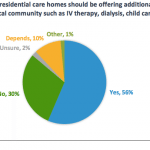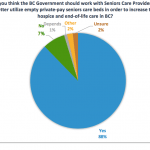
Following the release of these two major white papers last May, the BCCPA conducted a public consultation survey focused on obtaining feedback regarding the options outlined in them. In this update, we look at questions around new care models, and the idea of “care hubs” with additional services.
 Survey respondents were asked to indicate their support or opposition for residential care homes offering additional onsite services in the community, such as sub-acute care services, or community care services (e.g. day care). This policy option received modest support, with 56% of survey respondents indicating support, and an additional 10% indicating depends. Thirty percent of survey respondents indicated that they did not support this option.
Survey respondents were asked to indicate their support or opposition for residential care homes offering additional onsite services in the community, such as sub-acute care services, or community care services (e.g. day care). This policy option received modest support, with 56% of survey respondents indicating support, and an additional 10% indicating depends. Thirty percent of survey respondents indicated that they did not support this option.
Of those survey respondents that indicated depends, common themes were that it would depend on:
- Type of services being provided (i.e. many support sub-acute care services but not child care);
- Appropriate funding and staffing levels;
- Availability of these services in the community; and
- Whether those accessing services would pay a small fee.
While many survey respondents indicated that they were opposed to care homes offering child care services, there seemed to be some confusion about why a care home would offer child care. This may indicate that any public discussion on the provision of child care by care homes would need to clearly demonstrate the benefits of intergenerational interaction for seniors, as well as clearly outlining that child care services wouldn’t be provided to the detriment of seniors.
Additional Offsite Services
 Survey respondents were asked to indicate their support or opposition for residential care homes offering additional offsite services, such as adult day programs, recreational therapy and occupational therapy programs. This policy option received overall support from survey respondents, with over 80% supporting, and an additional 5 per cent indicating depends. Only 11% of survey respondents indicated that they would not support such an option.
Survey respondents were asked to indicate their support or opposition for residential care homes offering additional offsite services, such as adult day programs, recreational therapy and occupational therapy programs. This policy option received overall support from survey respondents, with over 80% supporting, and an additional 5 per cent indicating depends. Only 11% of survey respondents indicated that they would not support such an option.
Of those survey respondents that indicated depends for these options, common themes were that it would depend on:
- Whether those accessing the service would be charged a small fee – many survey respondents felt that those accessing the services should pay at least part of the cost of the service;
- The care home having appropriate resources, including funding and staffing levels; and
- The physical qualities of the building – some survey respondents felt that only specific built environments could accommodate these additional services.
End of Life Care
 Survey respondents were asked about whether they would support the use of under-used private-pay residential care beds and/or assisted living units being repurposed to deliver end-of-life care. Respondents overwhelmingly indicated support for this option, with almost ninety percent (88%) indicating support. Of those that indicated that they would not support this option, some indicated that this is because they would prefer that vacant private-pay beds be used for publicly-subsidized residential care clients, while others indicated that they would prefer that hospice and end-of-life care be provided in stand-alone hospices.
Survey respondents were asked about whether they would support the use of under-used private-pay residential care beds and/or assisted living units being repurposed to deliver end-of-life care. Respondents overwhelmingly indicated support for this option, with almost ninety percent (88%) indicating support. Of those that indicated that they would not support this option, some indicated that this is because they would prefer that vacant private-pay beds be used for publicly-subsidized residential care clients, while others indicated that they would prefer that hospice and end-of-life care be provided in stand-alone hospices.
To download a copy of the full report, click here.





